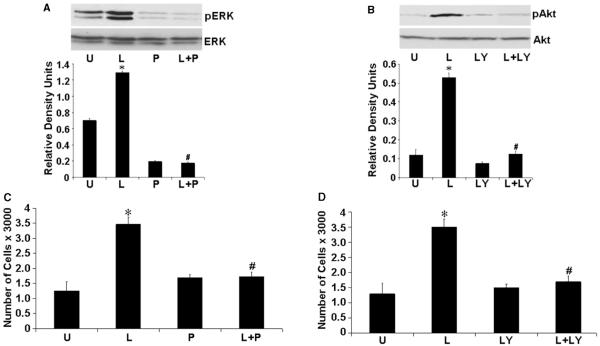Figure 4.
Leptin fails to stimulate proliferation of endometrial cancer cells in the presence of either ERK or AKT phosphorylation inhibitor. (A) Endometrial cancer cells were serum starved and stimulated with 100 ng/ml leptin (‘L’) or 10 μM PD098059 (‘P’). For combined treatment, cells were pretreated with 10 μM PD098059 for 45 min followed by leptin treatment (‘L+P’). Untreated controls are designated as ‘U’. Total proteins were immunoblotted with specific antibody against total or phosphorylated (p) forms of ERK. The representative histogram is the densitometric analysis of bands demonstrating fold increase in levels of phosphorylated ERK with respect to ERK. *P < 0.01, compared with untreated (‘U’) control cells; #P < 0.01, compared with leptin (‘L’) treatment. (B) Cells were treated with 100 ng/ml leptin (‘L’) or 10 μM LY294002 (‘LY’). For combined treatment, cells were pretreated with 10 μM LY294002 for 45 min followed by leptin treatment (‘L+Y’). Untreated controls are designated as ‘U’. Lysates were subjected to western blot analysis with specific antibody against total or the phosphorylated form of AKT. The representative histogram is the densitometric analysis of bands demonstrating fold increase in levels of phosphorylated AKT with respect to AKT. *P < 0.01, compared with untreated (‘U’) control cells; #P < 0.01, compared with leptin (‘L’) treatment. (C, D) Cells were treated with leptin, PD098059 (C), LY294002 (D) and combinations as described earlier and XTT assays were performed as described in ‘Materials and methods’. The data represent experiments performed in triplicates three times (means±s.e.m.). *P < 0.001, compared with untreated (U) control cells; #P < 0.005, compared with leptin (‘L’) treatment.

